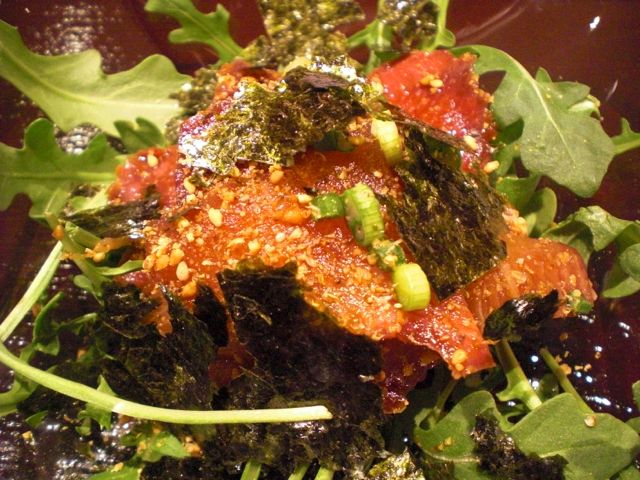For the New Year, I bought some burdock roots or gobou 牛蒡. One package contained two roots, which is a lot. So, after I used a portion for the New Year's dishes, I needed to finish up the remaining gobou. One evening I made these three gobou dishes.
Preparation of gobou is the same for all three dishes. The only difference is the shape of the pieces. I first halved the length of gobou since it is rather long and awkward to handle. Under running water, using the back of a vegetable cleaver or nakiri 菜切り包丁, I scraped off the dark skin. Depending on which dish I was making I cut the pieces differently but as soon as I cut the pieces, I soaked them in acidulated (with rice vinegar) water. Before using, I washed the pieces in cold water and dried them well using paper towels.
1. Soma-age 杣揚げ
The first one below is called "soma-age". "Soma"
杣 means wood or lumber cut from a mountain and the resemblance of this dish to the name-sake is rather obvious. I somehow remembered this dish from the depth of my memory (old drinking snack cook book*). It is like tempura but buckwheat flour or sobako そば粉 is used, which gives a nice crunchy texture and nutty flavor to this dish. It is a variation of
gobou karaage 牛蒡の唐揚げ but it is different enough to warrant a different name.
I cut the gobou into 2 inch long pieces and then halved it lengthwise. I then placed the cut side down and sliced it rather thinly (2-3 mm or 1/5 inch) lengthwise. The central pieces were too wide so I cut them in half again lengthwise producing match sticks of gobou. After soaking them in acidulated water for 10 minutes, I washed them in fresh cold water, then patted them dry with paper towels.
Batter: I used buckwheat flour (2-3 tbs) and a pinch of salt. I added enough cold water to make a rather thick batter.
Frying: I individually coated the gobou sticks and deep fried them in 340F peanut oil for one minute or until done and drained them over several layers of paper towels.
This is best eaten while hot. The buckwheat crust and fried gobou are indeed a winning combination. We like this variation better than kara-age, although both are excellent Izakaya food.

*Later, I located this old cook book of drinking snacks by Shino Ikenami 池波志乃 called "Drinking snacks extraordinary" or 酒肴とびっきり and looked up the dish I made. It turns out I was actually, combining two of her recipes; one is tempura of "mountain" vegetables 山菜 using buckwheat flour batter and another is the original form of this dish; "gobou no soma-age" 牛蒡の杣揚げ, in which she used regular tempura batter. Although no new printing is being produced, surprisingly,
this book (used) is still available (It was published in 1983).
2.gobou chips 牛蒡チップス
This is rather straight forward. I just sliced gobou on a slant rather thinly (paper thin). After soaking in acidulated water, I rinsed them and then patted them dry with paper towels. I simply deep fried the pieces for less than a minute in 320-330F peanut oil until brown and crispy turning once. While it was draining on the paper towel, I sprinkled on kosher salt.
This is like potato chips but gobou has a much more earthy nutty flavor. This fried up nicely and was not oily at all. It was nicely light and crunchy.
3 Stir fried "Kimpira" burdock root 金平牛蒡
This is by far the most popular preparation of gobou. It is a classic and still excellent. I
have posted this before and will not repeat myself.
We had these three gobou dishes with California cab, Consentino 2005. This wine has a rather classic flavor profile of Califronia Cab in a good way. After tasting some austere Italian wines, we had to admit we like California reds like this one much better. This wine has a nice black and red fruit upfront with dark chocolate and vanilla with spices and moderate tannin.
Somehow this was a perfect wine with the gobou dishes. This red particularly went swimmingly with the "soma-age" burdock. Although I had to admit, these dishes will go well with beer or sake as well.





